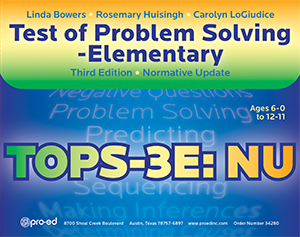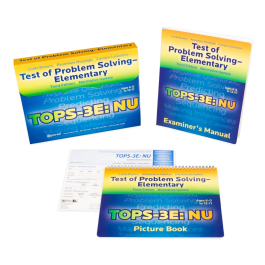Linda Bowers / Rosemary Huisingh / Carolyn LoGiudice
Ages: 6-0 through 12-11
Testing time: 35 minutes
Administration: Individual
The TOPS-3E: NU assesses a school-age child's ability to integrate semantic and linguistic knowledge with reasoning ability by way of picture stimuli and verbal responses.
The TOPS-3E: NU focuses on students' linguistic ability to think and reason. Language competence is the verbal indicator of how a student's language skills affect his ability to think, reason, problem solve, infer, classify, associate, predict, determine causes, sequence, and understand directions. The test focuses on a broad range of language-based thinking skills, including clarifying, analyzing, generating solutions, evaluating, and showing affective thinking.
While other tests may asses students' thinking skills by tapping mathematical, spatial, or nonverbal potential, the TOPS-3E: NU measures discreet skills that form the foundation of language-based thinking, reasoning, and problem-solving ability.
Although the skills tested on the TOPS-3E: NU are necessary for developing social competence, it is not primarily a test of pragmatic or social language skills. Rather, it should be part of a battery of tests and observations used to assess pragmatic competence.
New Features
Characteristics of the normative sample were stratified by age relative to region, gender, ethnicity, and socioeconomic factors, and other critical variables are the same as those reported for the school-age population reported the ProQuest Statistical Abstract of the United States, 2016 (ProQuest, 2016).
The Total Score was renamed the Problem Solving Index and calculated as a standard score with a mean of 100 and a standard deviation of 15.
Each item on the test was evaluated using both conventional item analysis to choose good items and differential item analyses to find and eliminate potentially biased items.
The index score was thoroughly examined for floor and ceiling effects.
The test was subjected to diagnostic accuracy analyses, particularly rigorous techniques involving the computation of the receiver operating characteristic/area under the curve (ROC/AUC) statistic.
The Examiner's Manual was reorganized and rewritten to provide more detailed information on the administration, interpretation, and statistical characteristics of the test.
(TOPS3ENU-1) Test of Problem Solving
Elementary, Third Edition Normative Update




